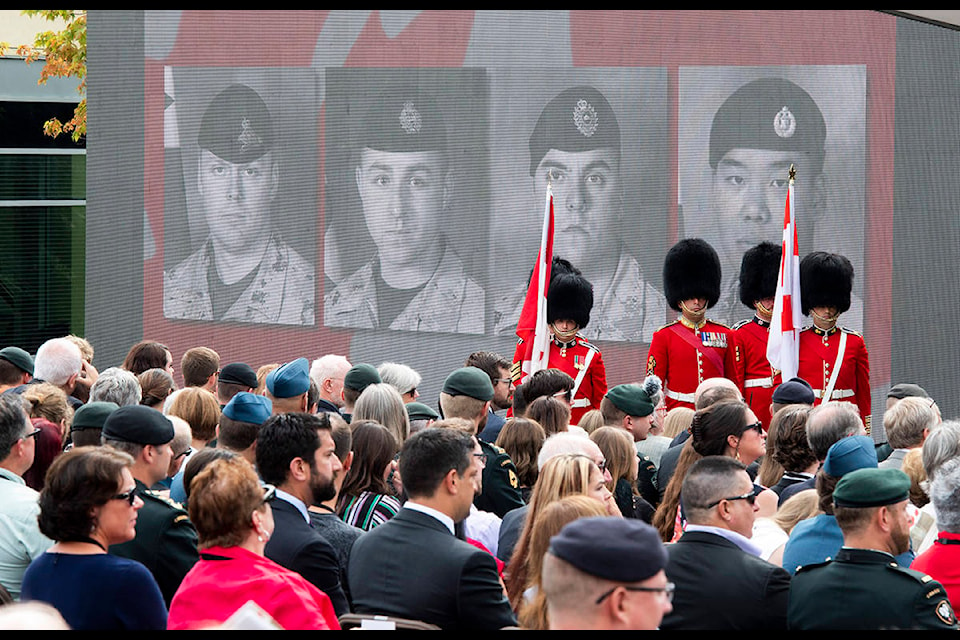Emotions ran free in Ottawa Saturday as the more than 150 Canadians killed in Afghanistan were honoured during a sombre ceremony attended by hundreds of family members, many of whom continue to struggle with the loss of their loved ones.
The ceremony involved the re-dedication of a cenotaph built during the war in honour of the fallen. It stood first in Kabul and later at the Kandahar Airfield, where the Canadian Forces was headquartered for most of its time in Afghanistan, serving as a place of reflection and remembrance for those overseas.
Under overcast skies, the families and former comrades of the fallen listened as Gov.-Gen. Julie Payette, Defence Minister Harjit Sajjan, defence chief Gen. Jonathan Vance and others spoke of the enduring legacy left behind by those who fought and died during Canada’s 13-year war in Afghanistan.
One-hundred-fifty-eight Canadian soldiers died during the mission, which started shortly after the terrorist attacks on Washington and New York City on Sept. 11, 2001. Canadian diplomat Glyn Berry, journalist Michelle Lang and two civilian contractors were also killed during the war.
“Because of their sacrifice, the Kandahar stadium is used for playing soccer,” Sajjan, who served two tours in Afghanistan, told those in attendance. “Because of their sacrifice, young girls are allowed to freely go to school. Because of their sacrifice, we are safer at home. We will never forget the price these women and men paid.”
Yet much of the ceremony focused on the families of those who died, whose lives were irreversibly changed during the mission even as much of the rest of the country moved on, turning the page on the war in Afghanistan when the last Canadian troops returned home five years ago.
Families like that of Pvt. David Robert James Byers, whose daughter was born a few months after he and three other Canadian soldiers were killed by a suicide bomber in September 2006. Byers’ mother Catherine Jane Byers and his daughter were among the 600 family members to attend Saturday’s ceremony.
READ MORE: Canada marks fifth anniversary of end of Afghanistan mission
“We’re the ones that live with this every day,” Catherine Jane Byers said as she stood outside the specially built memorial hall where the cenotaph, comprised of plaques bearing the names and pictures of the fallen, is housed. “We’re the ones that celebrate birthdays. See our grandchildren grow up without a father. That is our reality.”
The re-dedication ceremony at the Department of National Defence’s new headquarters building in west Ottawa was actually a redo for the military, which came under fire after holding a private event in May. Some families were angry they were not invited at that time, prompting an apology from Vance and plans for Saturday’s event.
Afterward, Catherine Jane Byers and several other relatives of those killed in Afghanistan told reporters they were grateful for the second ceremony, during which Payette, Sajjan and the rest underscored this country’s gratefulness to those who paid the ultimate price — and the loved ones they left behind.
“All of you who lost someone … you know what has been lost,” Payette said. “A wound that this memorial can acknowledge even if it cannot fully heal. But it must be acknowledged, and that is why we are here today, to focus our attention on these brave men and women and the people who loved them.”
While many family members struggled to contain their emotions during the ceremony, which included the laying of wreaths, a flypast by Canadian Forces aircraft and the playing of the Last Post and the Lament, they weren’t alone; Vance was forced to stop several times during his remarks to gather his composure and wipe away tears.
Vance served two tours in Afghanistan in 2009 and 2010, a time period that coincided with some of the worst losses for the Canadian military during the war. He recalled his visits to the cenotaph when it was in Kandahar, saying it served as not only a place of mourning but also of solace and comradeship for those who served on the mission.
“The cenotaph contains the grief,” Vance said, “but also carries the hopes and fear, the courage and vitality of the people who lived and those who died and the mission they were trying to accomplish.”
Some have questioned whether the cenotaph, which was designed and built by Canadian soldiers in Afghanistan, should be in a more public space rather than its current location inside what is essentially a security zone. Anyone wishing to visit it now must register with the Defence Department for a guided tour.
Theresa Charbonneau, whose son Cpl. Andrew Grenon was killed along with two other soldiers when their armoured vehicle was attacked in September 2008, supported the current location in part because of that security but also because of its day-to-day proximity to other service members.
“I know it’s under lock and key. I like it under lock and key,” she said, adding: “Where else would we put it so that it could be close to their comrades? NDHQ is the perfect spot. Their lives were involved here. This was their second family. This is a good place for it.”
The government has promised to build a separate national memorial for the war in Afghanistan that will be placed in a public site near the Canadian War Museum.
Jim Davis, whose son Cpl. Paul Davis was killed when his vehicle flipped in Kandahar in March 2006, said he would continue to visit the cenotaph, which carries a special meaning for the families of the fallen as well as all those Canadians who served in Afghanistan.
“I feel not only my son’s spirit, I feel the spirit of his fallen comrades,” Davis said. “I can go to his grave and he’s not there. But if I go in here, his spirit’s in here. I feel it.”
Lee Berthiaume, The Canadian Press
